When deciding on the right John Deere equipment for your needs, you may find yourself comparing the E Series and G Series. Both lines are crafted to cater to different aspects of work, with the E Series focusing on utility and functionality in a more cost-effective package, while the G Series is engineered to offer more in terms of power and advanced features. The E Series brings an impressive set of capabilities suited for a variety of tasks, making it a strong contestant in its price bracket.
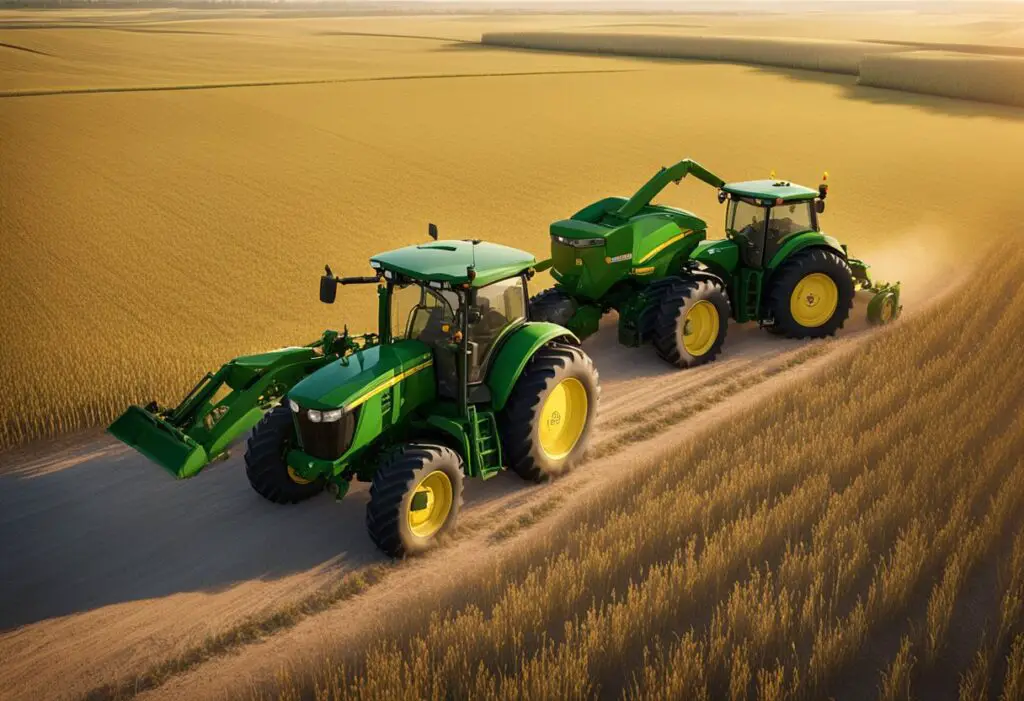
In contrast, the G Series is designed with an all-new operator station that prioritizes comfort and visibility, and these machines often include enhancements like increased legroom and improved entry and exit points. The G Series, not to be outdone, usually boasts additional refinements to meet the evolving demands of more intensive job sites. Factors such as these often reflect the diverse requirements of operators and play a crucial role in determining which series would best suit your operations.
Key Takeaways
- The E Series is cost-effective and highly functional for diverse tasks.
- The G Series offers advanced comfort and power for intensive work.
- Choosing between the two depends on specific operational needs and preferences.
Overview of John Deere E Series and G Series
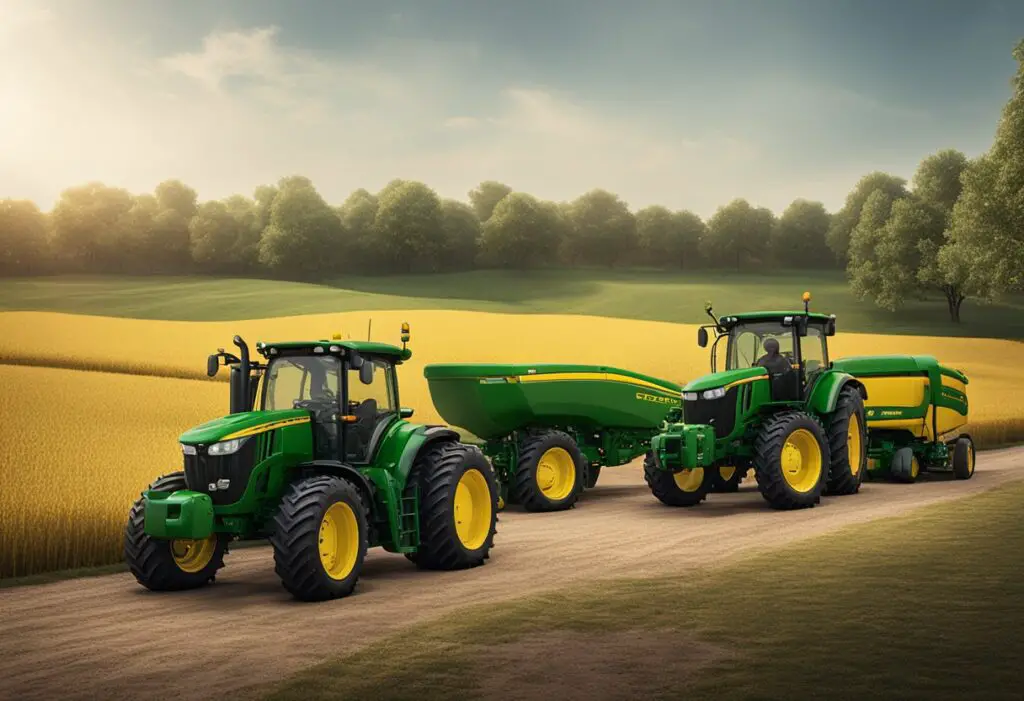
In your search for rugged machinery, John Deere’s E Series and G Series stand out for their specialization in construction and landscaping, offering a range of compact track loaders, skid steers, and lawn tractors tailored to meet diverse operational needs.
Historical Development of E and G Series
E Series: The inception of the E Series marked a significant advancement for John Deere, especially noted for the introduction of features such as a reversing function that aids in keeping the engine compartment clean—particularly beneficial in sticky feed situations. The 333E model is recognized as the largest compact track loader in this series, showcasing the breadth of Deere’s innovation for heavy-duty tasks.
G Series: Following the E Series, the G Series further refined the operator experience with an upgraded operator station that boasts enhancements initially pioneered in the E Series machines. This series also meets the stringent Tier 4 emissions requirements, indicating Deere’s commitment to environmental responsibility while elevating operational standards across its skid steers and track loaders.
Target Market and Application Scenarios
Whatever your role—be it construction manager, farmer, or landscape professional—the E Series shines when robust performance and versatility are paramount. This series primarily attracts those in agricultural or heavy-duty work settings where frequent engine maintenance is typical because of challenging materials.
On the other side, your G Series equipment offers improvements in operator comfort and complies with environmental regulations, making it an attractive choice for those working in urban constructions and landscaped environments where extended use is common and emissions are a concern. These machines cater to the needs of professionals striving for efficiency without compromising on environmental consciousness.
Overall, both series exemplify John Deere’s dedication to providing you with machinery that is not only powerful and dependable but also attuned to the specific demands of your trade.
Technical Specifications
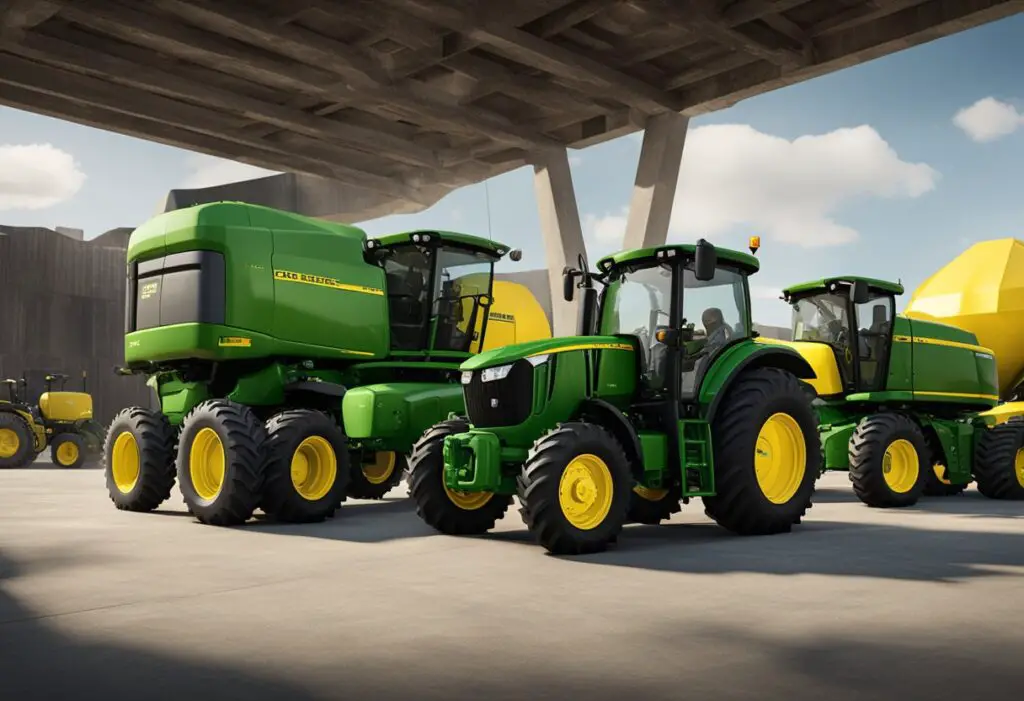
In your comparison of John Deere’s E-Series and G-Series, you might be particularly interested in how these machines stand out in terms of engine capabilities, the robustness of their drive systems, and the comfort and functionality of the operator’s cab.
Engine Performance and Power
The E-Series boasts notable engine advancements with models like the 333E offering 10-percent more engine power than previous iterations, specifically delivering a tipping-load capacity up to 4279 kg (9425 lb.). The G-Series steps it up further, with even more horsepower and improvements in emissions standards to meet the modern environmental guidelines. For instance, the 333G brings to the table more breakout force over its predecessors.
- E-Series Horsepower: Ranges with a net engine power increase by 5% in models 319E and 323E, and 4% more in 329E.
- G-Series Horsepower: Improved even further, but specific numbers would require matching to individual model specifications.
Transmission and Drive Systems
Both the E-Series and the G-Series are equipped with high-torque transmissions, but the G-Series has evolved with enhancements in the undercarriage design and drive systems for better durability and performance.
- E-Series: Features strong hydrostatic transmissions with different drive modes to give you control over your machinery’s responsiveness.
- G-Series: Offers the latest in John Deere’s drivetrain technology, improving on the E-Series’ already solid capabilities.
Operator Cab Features
Your comfort and efficiency as an operator are paramount with John Deere. The E-Series offers programmable fan options and manual reversing to keep the engine compartment clear.
- Cab Comfort: Both series prioritize operator comfort with ergonomic seating, air-conditioning, and optimized control layouts.
- Visibility and Lighting: Enhanced lighting packages in the G-Series improve visibility, crucial for safely operating the machinery in low-light conditions.
Overall, newer G-Series models come with additional refinements in the cab’s interior for an even more comfortable operator experience. However, it’s evident the E-Series also places a significant emphasis on ensuring your work is as efficient and as comfortable as possible.
Model Comparisons
When considering the purchase of a John Deere tractor, you’ll want to know the specifics of the E Series and G Series to make an informed decision. Let’s break down the options within these series, so you can match your needs with the right model.
E Series Model Breakdown
The E Series from John Deere includes a range of utility tractors that are designed to handle a variety of tasks around your property with ease. Models from this series, like the 316GR, 318E, and the economical 312GR, offer a reliable set of features suitable for landscaping, groundwork, and more. Within the lawn tractor lineup, the E Series also extends to residential models, including the 100 Series with options such as the E100, E110, E120, E130, E140, E150, E160, E170, and E180.
- 316GR: Compact size and versatility.
- 318E: More power and lifting capability.
- 312GR: Ideal for tighter spaces and smaller tasks.
G Series Model Breakdown
Whereas the G Series is known for its ruggedness, ideal for more demanding work environments. Models in the G Series, such as the 314G, are built to withstand tougher conditions and provide consistent performance for construction and agricultural tasks. For those who need a little more from their lawn tractors, options from the higher-spec’d X300 series, including the X350, provide advanced features compared to their E Series counterparts.
- 314G: Durability and strength for challenging jobs.
- X300 Series: Enhanced features and capabilities beyond the E Series.
- X350: Precision mowing with comfortable operation.
Attachments and Accessories
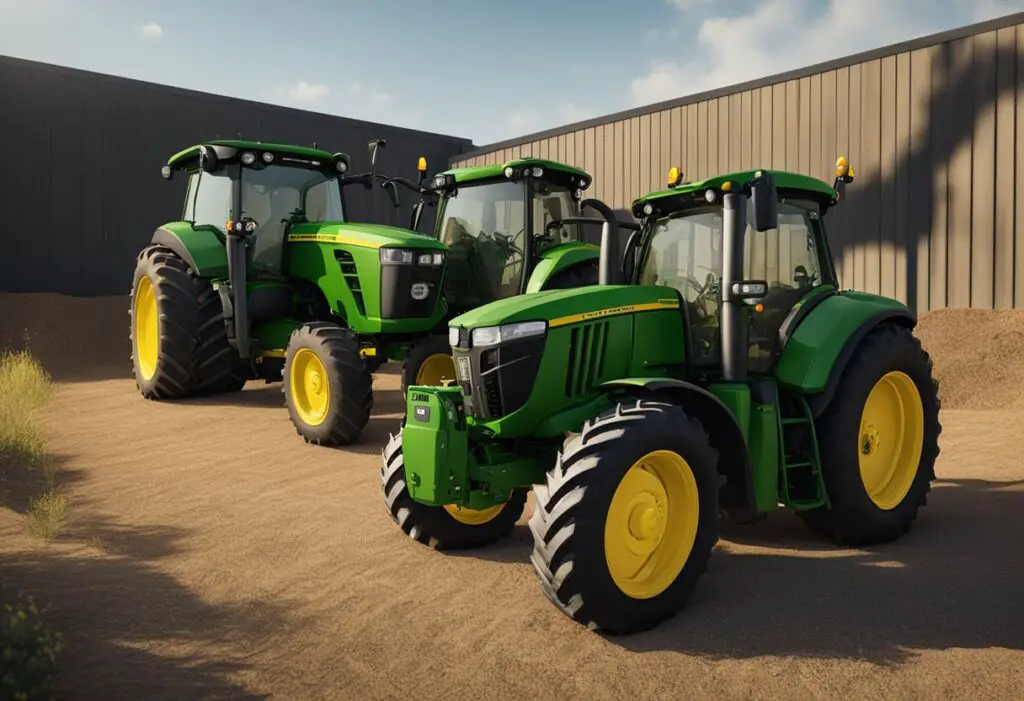
When exploring the versatility of the John Deere E Series and G Series, you’ll find a selection of attachments and accessories to extend their capabilities, ensuring that your machine meets your specific needs.
Mower and Tiller Attachments
Your John Deere tractor can transform into an efficient mowing and tilling machine with the right attachments. Mower attachments come in various deck widths to suit the size of your property. A 48-inch deck strikes a balance for most yards, but options are available for wider or narrower needs.
- Mower Attachments:
- Deck Widths: 42-inch, 48-inch, 54-inch (for different E Series models)
- Compatibility: E Series like the E100, E200, etc.
- Features: Easy attach/detach for convenience
Tiller attachments enhance the E Series’ gardening and landscaping prowess. They’re designed to work well for soil preparation and weed control.
- Tiller Attachments:
- Robust blades for thorough tilling
- Compatibility: Tailored to fit E Series models
Loader and Earthmoving Attachments
If your work involves moving earth or heavy lifting, John Deere’s loader attachments are indispensable. These include buckets and blades suited for land-leveling, digging, and material transport.
- Loader Attachments:
- Types: Standard buckets, multi-purpose buckets, and materials forks
- Compatibility: E and G Series depending on the attachment
- Front Bumper: Protects your machine during heavy-duty tasks
These attachments are just a few examples of how you can customize your John Deere E Series or G Series to handle various jobs confidently and effectively.
Operating Experience
When you slip into the seat of a John Deere E or G Series machine, you’re not just taking control of some of the finest equipment— you’re stepping into a tailored operating environment. Your productivity is at the forefront of design, with comfort and control that connect you to your task with ease and efficiency.
Comfort and Ergonomics
In the E-Series, you’ll notice an operator station that puts your comfort first. John Deere has designed these models with ample legroom, and feeling snug during a long day’s work is a given thanks to an adjustable suspension seat. The G-Series takes operator comfort further with ergonomic refinements, boasting features like flat floors for easy entry and exit, and increased foot and legroom to minimize fatigue.
- E-Series:
- Standard suspension seat
- Ample legroom
- G-Series:
- Swing-out cab door for wide entry
- Flat floors and spacious legroom
- Enhanced seat comfort
Control Patterns and Steering
Your control over the machine can make a significant difference in how effectively you work. Both series offer optional self-level and ride control features, which aid in material retention and improve the ride. When it comes to control patterns, both the E and G Series offer H-patterns and ISO controls to match your style. However, you might appreciate the G-Series’ exclusive one-person boom lockout system, which ensures safer maintenance and adjustments.
Moreover, for your steering comfort, there’s tilt steering, matching the console to your preferred position for an effortless steering experience.
- E-Series:
- H-pattern and ISO control options
- Tilt steering for comfort
- G-Series:
- H-pattern and ISO controls
- One-person boom lockout system
- Tilt steering
Maintenance and Service
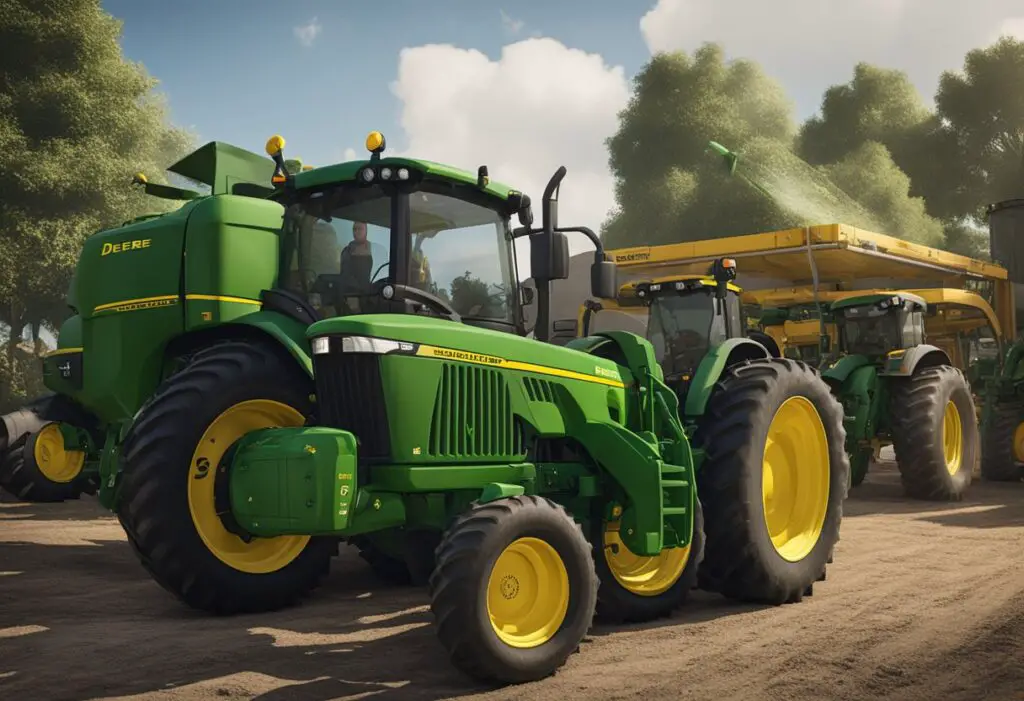
Maintaining your John Deere machinery is crucial to ensure longevity and optimal performance. John Deere’s E Series and G Series have specific maintenance features and service intervals that are designed to reduce operating costs and extend the durability of the machines.
Ease of Maintenance
Your John Deere E Series equipment is engineered to simplify maintenance tasks. The E Series offers easy-to-access checkpoints and extended service intervals, reducing your time spent on upkeep. For example, the E Series skid steers have an accessible engine compartment making it easier to clean out debris. The E Series machines typically feature:
- Transparent fuel and coolant tanks for quick level checks
- Swing-out doors and panels providing full access to filters and engine components
In contrast, the John Deere G Series also focuses on efficiency in maintenance. With grouped service points and engine access, you’re able to perform routine checks effortlessly. The compact excavators in the G Series are particularly known for convenient access to:
- Side-by-side coolers that enhance cleaning efficiency
- Hinged doors for straightforward engine service
Service Intervals and Longevity
When it comes to service intervals, the E Series machines might require less frequent visits to the shop. This means more time in operation and less time in maintenance. You’ll find that:
- Oil change intervals are extended, with some models only needing an oil change every 500 hours.
- The cooling system is designed for long-term performance with auto-reversing fans to keep the engine clean.
The G Series has a strong reputation for durability, and this extends to its service intervals and parts longevity. Its maintenance plan ensures that you’re getting the most out of your equipment with aspects such as:
- Fuel-efficient engines that help to extend service intervals and reduce operational costs
- Durable components like heavy-duty coolers and batteries to enhance the machine’s lifespan
Cost Considerations
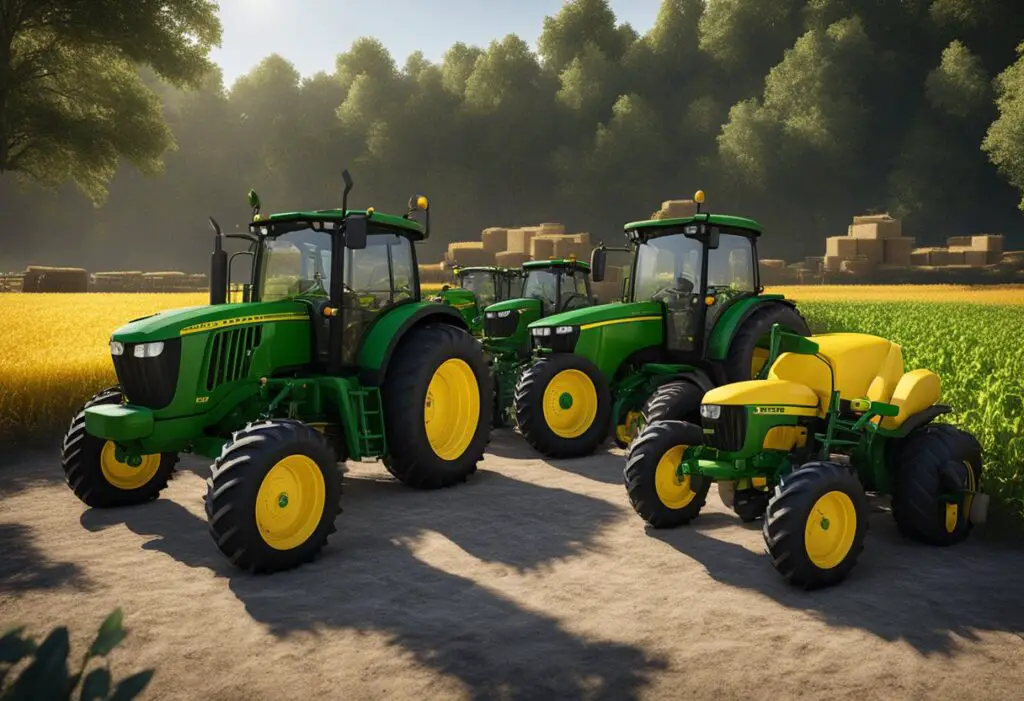
When you’re comparing the John Deere E Series and G Series, the cost is a significant factor. You’ll have to consider not only the initial price but also the long-term costs associated with ownership.
Price Comparison
The E Series tends to be more budget-friendly in terms of upfront cost, with the series designed to offer essential features at a more accessible price point. In contrast, the G Series excavators, such as the 35G, 50G, and 60G, come with additional features and enhanced capabilities, which naturally come with a higher initial price tag.
- E Series: More affordable upfront
- G Series: Higher cost reflects advanced features
Cost of Ownership
Your total cost of ownership extends beyond the purchase price. Here, operating costs and potential rental income are vital considerations.
- Operating Costs: Consider fuel efficiency, maintenance requirements, and parts availability. The G Series excavators, due to their advanced technology to meet Tier 4 emissions standards, may have higher associated operating expenses.
- Ownership: Owning a G Series could mean heftier insurance costs due to higher valuation, but also the potential for greater resale value.
Consider your usage frequency. If you don’t need a machine year-round, renting may be a cost-effective option.
- E Series: Lower insurance and possibly lower maintenance costs
- G Series: Potentially higher resale value and more robust performance
Customer Insights and Feedback
When considering the John Deere E Series and G Series, your decision may be influenced greatly by what others have experienced. Below, insights from media events showcase the features and demonstrations, while user reviews provide personal accounts from people like you who operate these machines.
Media Event Highlights
During recent media events, John Deere highlighted the capabilities and upgrades of their E Series and G Series. For instance, the E Series skid steers and compact track loaders (CTLs) were noted for introducing a reversing function that helps prevent debris buildup, a feature particularly appreciated by dairy operators. Additionally, the G Series was showcased with customer-driven improvements, such as enhanced emission standards that align with the Tier 4 requirements. Events like the Coal Valley Rally have been used by Deere to demonstrate the capabilities of these machines, like the E Series’ robust 333E compact track loader and the G Series’ compact excavators like the 35G, 50G, and 60G.
User Reviews and Testimonials
User reviews offer a wealth of knowledge. Many testimonials speak to the efficiency of the maintenance features of the E Series. For example, operators appreciate the programmable fan that helps keep machines clean. When it comes to the G Series, feedback often centers on improved engine performance and usability. Owners of the G Series skid steers highlight the ease of operation and smooth control response, with the 318G model receiving particular praise for its user-friendly interface and power.
- E Series Positives:
- Reversing fan feature
- Operator programmability
- G Series Positives:
- Tier 4 emissions compliance
- Enhanced engine performance
- Easy operation controls
Regulatory Compliance and Environmental Impact
When comparing John Deere’s E Series and G Series, it’s vital to note how each aligns with regulatory compliance, particularly concerning Tier 4 emissions requirements. This regulation mandates that diesel engines reduce their environmental footprint, primarily by cutting down on particulate matter and nitrogen oxides emissions.
The E Series, a line of skid steers and compact track loaders, has been designed keeping these requirements in focus. For instance, the 333E model is equipped with features to manage emissions effectively.
Meanwhile, the G Series, which includes compact excavators like the 35G, 50G, and 60G, has been adapted to meet these stringent standards. This series emphasizes not just compliance with environmental policies but also operational efficiency and longevity of the machines.
Your interests in eco-conscious practices are shown in the choices made by John Deere:
- E Series: Offers reversing fan function to clear out debris, aiding in engine efficiency.
- G Series: Implements fuel-efficient engines that dovetail with Tier 4 requirements without sacrificing power.
By adhering to these regulations, you are investing in machinery that not only meets current legal standards but also reduces the overall environmental impact, paving the way for a more sustainable operation. Moreover, the adaptation to these emission standards signifies a substantial investment by manufacturers like John Deere to meet these critical environmental benchmarks.
Industry Trends and Innovations
In the ever-evolving landscape of heavy machinery, John Deere’s E and G series stand out with their embrace of technology and efficiency. You’ll notice how these advances directly impact performance and usability.
Technological Advancements
The E-Series boasts a unique reversing function on their skid steers and compact track loaders (CTLs), which is a significant stride in operational technology. This allows you to keep the engine compartment clear of debris by reversing the fan — a feature you can set manually or schedule automatically. In the realm of excavators, the G-Series offers compact models like the 35G, which are designed to incorporate the latest in hydraulic and control technologies, enabling precise landscaping work.
E-Series:
- Beneficial reversing fan function.
- Programmable for convenience.
G-Series:
- Advanced hydraulic technologies.
- Enhanced control for precision.
Efficiency and Performance Improvements
When it comes to efficiency, both the E and G series have made leaps to meet Tier 4 emissions requirements, reflecting John Deere’s commitment to environmental responsibility without compromising on power. The larger models, such as the 50G and 60G excavators, balance this with the necessary horsepower that heavy-duty tasks demand.
- Emissions and Power:
- Meet Tier 4 standards.
- Maintain high performance levels.
Both series exemplify an improved user experience with enhanced horsepower, weight capabilities, and raw power even in standard models, pushing the boundaries of what you can achieve with compact machinery.
Comparative Analysis of Performance
In comparing the John Deere E Series and G Series, you’ll find that both offer distinct performance characteristics, especially regarding power, efficiency, and lifting capabilities. Let’s dive into the specifics without any fluff.
Power and Efficiency
Horsepower (HP): The John Deere E Series machines are well-regarded for their efficient engines delivering ample power for various tasks. However, the G Series often eclipses the E Series with a heftier horsepower output.
Table: Sample John Deere Models Horsepower Comparison
| Model | Series | Horsepower (HP) |
|---|---|---|
| 312GR | E | 51 |
| 317G | G | 65 |
Italics indicate sample data for illustrative purposes.
Efficiency: Your John Deere G Series equipment typically incorporates more advanced engine technology, boosting operational efficiency. This improvement takes into account better fuel consumption rates and can translate into longer operational times between refueling, compared to the E Series.
Lifting Capabilities
Vertical Lift: The E Series compact track loaders may offer significant vertical lift capabilities which are suitable for your general lifting tasks. On the other hand, the G Series implements John Deere’s latest vertical-lift designs, which could mean better load stability and increased lift height for you.
Breakout Forces:
- E Series: Solid breakout forces ideal for your day-to-day material handling.
- G Series: Enhanced breakout forces, which means you can handle heavier materials more confidently.
Vertical Lift Models Comparison:
- E Series: Offers competent vertical lift models that provide reliable and effective lifting performances.
- G Series: Vertical lift models in the G Series may come with reinforced lift arms, delivering greater strength for your heavy-duty lifting tasks.
Remember, when you’re considering a John Deere CTL, the lifting capabilities are critical, and the G Series aims to give you that edge in power and performance.
Brand Reputation and Market Presence
You’re probably aware that John Deere is a name that carries weight in the world of construction and agriculture. Their reputation is built on a foundation of quality and innovation, reflecting over 180 years of experience. With a history dating back to 1837, it’s a brand that has become synonymous with durability and reliability.
In the market, John Deere has a substantial presence, often associated with a customer-focused approach. This is evident in their practice of incorporating user feedback into product development, as showcased by their G-Series.
Here is what you should know about John Deere’s standing:
- History: Established in 1837, consistently delivering trusted equipment.
- Innovation: First to offer reversing function in E-Series, according to ‘Farm Progress’.
- Market Rank: Ranked 97th in Fortune 500 America’s list (as of 2016), indicating a strong market presence.
- Customer Feedback: Acknowledged for listening to customers, resulting in the G-Series’ features.
- Construction Equipment: E and G Series are known for their use in construction, with the G-Series particularly shaped by customer suggestions.
John Deere’s E and G series machines showcase their commitment to meeting market needs while never straying from the high standards they set in the industry. They continue to hold a distinguished spot in both the construction sector and the public’s view because of their ability to evolve with technological advancements and environmental considerations.
Final Thoughts on John Deere E Series vs G Series
When you’re considering the John Deere E Series tractors, you’re looking at models that are known for their economy and practical features. The E Series is tailored for those of you who require a reliable machine that covers essential functions without the extensive array of additional features.
In contrast, the G Series—not explicitly mentioned in your search results and potentially referring to older or different models—would generally imply a range of tractors offering more robust engines and possibly greater horsepower. These might come with upgraded features that are beyond the basic necessities provided in the E Series.
Here’s a quick comparison to highlight the distinctions:
- Engine Performance: G Series may offer larger engines and elevated horsepower.
- Features: E Series focus on economy; G Series could include more advanced functionalities.
Your choice should align with your workload demands and personal preferences. Are you seeking straightforward efficiency or are enhanced capabilities more your focus? Each series offers you distinct advantages:
| Series | Key Advantage |
|---|---|
| E Series | Cost-efficiency and essential features |
| G Series | More powerful performance and additional features |
Remember, these are general observations. It’s always best to consult with a dealer or a detailed specification sheet for the most accurate information pertaining to each model. Your ideal tractor awaits you, perfectly suited to your farming or landscaping needs.
Frequently Asked Questions
In this section, you’ll find detailed answers to some common queries regarding the specifications and features of John Deere’s E Series and G Series.
What are the main differences in specifications between the E series and G series models?
The E series and G series from John Deere differ mainly in their advancements, with the G series being equipped with features like unique cooling designs—V-plenum and Tri-Cool—and enhanced operator stations with greater comfort and visibility. The E series introduced the reversing fan function for better engine compartment maintenance.
How does the operating weight compare between the E series and G series?
The operating weight for both series can vary significantly based on the specific model. For example, the 320E skid steer loader has an operating weight of approximately 8,157 lbs, while the similar class 320G model might differ slightly due to design enhancements. It’s essential to refer to the official John Deere specifications for accurate comparisons.
Can you provide a price comparison for the E series versus the G series?
Precise pricing can fluctuate based on dealer, location, and available features. The G series, being a newer iteration with updated features, may command a higher price point compared to the E series. To get accurate pricing, it’s best to contact a John Deere dealer directly.
What distinguishes the 333E model from the 333G?
The 333E compact track loader is the largest in the E Series and is known for its size and reversing function. The 333G, while similar in size, features an all-new operator station and improvements in comfort and operational efficiency.
What features separate the D series from the G series in John Deere?
The D series is an older line of John Deere equipment compared to the G series, which houses more modern features like improved cooling systems and enhanced operator stations. The G series represents a step up in terms of performance and ergonomic enhancements.
What are the specific capabilities of the John Deere 324G?
The 324G skid steer loader in the G series boasts updated designs for superior performance, particularly in challenging, high-load conditions. It’s designed for efficiency and durability, intended to support tasks that require significant power and control.

Leave a Reply